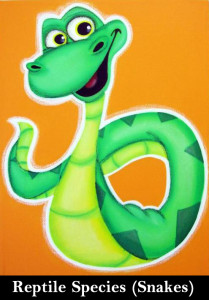In Previous Part of this article we have seen the interesting things about reptile species, now in this article we will get more familiar with the classification of snakes.
Classification of Snakes
Snakes are in the sub-order Serpents. They share the order of Squamata with lizards and Amphisbaenas. They are in the class Reptilian which includes turtles, crocodiles (alligators, crocodiles, etc.) and the rare-in-its-own-order. Lizards, though in appearance strikingly very different, are the closest relatives to snakes.
All snakes have a similar body shapes, but their girth can vary. For example, 5 feet long ‘Coach whip snake’ weight less than 1 pound, on the other hand a 5 foot long ‘Eastern Diamondback rattlesnake’ weights up to 6 pounds.
- Snake Head–
Compared to the body, the head is light and very small as they cannot chew or tear their food. A snake’s skull is evolved to stretch and swallow prey much thicker than its own head. They have up to 200 hundred teeth in their jaws; they are constantly growing in new teeth as the old ones fall out. They can dislocate the bones in their jaw to fit large prey.
- Internal Body Of Snakes–
The organs are elongated so that they can fit in a long, cylindrical body. The heart is rather normal compared to some other organs and have one fully functional lung; which is one-third the length of the snake. Another lung is tiny, and in most snakes it is useless. . The kidneys are small, and lima bean shaped. The intestines, stomach, and liver are very long and the stomach can expand so that they can eat large prey. Almost everything a snake eats is digested. Males have two reproductive systems called the hemipenes. Female has a pair of scent glands that during the breeding season release “pheromones”.
- Outer Body Of Snakes–
Snakes have skin scales which are made of keratin (substance fingernails are made of). A snakes eye is covered by a clear scale called the ‘brille’ which protects it eyes from dust, debris, and injury. The scales serve to protect the snake’s skin, enable serpentine locomotion. From time to time the snakes shed the outer layer of their scales. This is a common misconception that snakes shed their skin but it’s wrong they actually only shed the outer layers of the skin as this part is incapable of growing. This is done by secreting a special fluid between the layers of the skin which causes the skin to separate and soften. After few days the skin and eyes clear up. A couple of days after that, the snake rub its snout against something abrasive and the skin around its head starts to peel.
Do Snakes have feelings?
It’s not fair to say that snakes are dumb. It is true to say that snakes act mainly through “instinct”. For instance, a lot of snake keepers say when they go to their rattlesnakes, the snakes act calm and normal. Problem arises they rattle vigorously and take defensive poses when other people try to approach them. It is nice to think that snakes have emotions (like joy, anger, and affection), scientific studies show that snakes just don’t have the cerebral capacity for them. However, snakes have some feelings like aggression, fear, and pleasure. It’s impossible to teach a snake to learn things like to “fetch” (like a dog can), or “sit-stay” is not relevant to snakes. Snakes learn simple things such as tolerating handling, eating a food item, and adapting to captivity.
